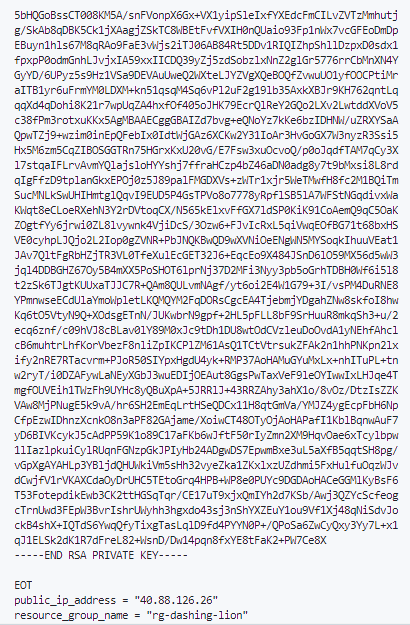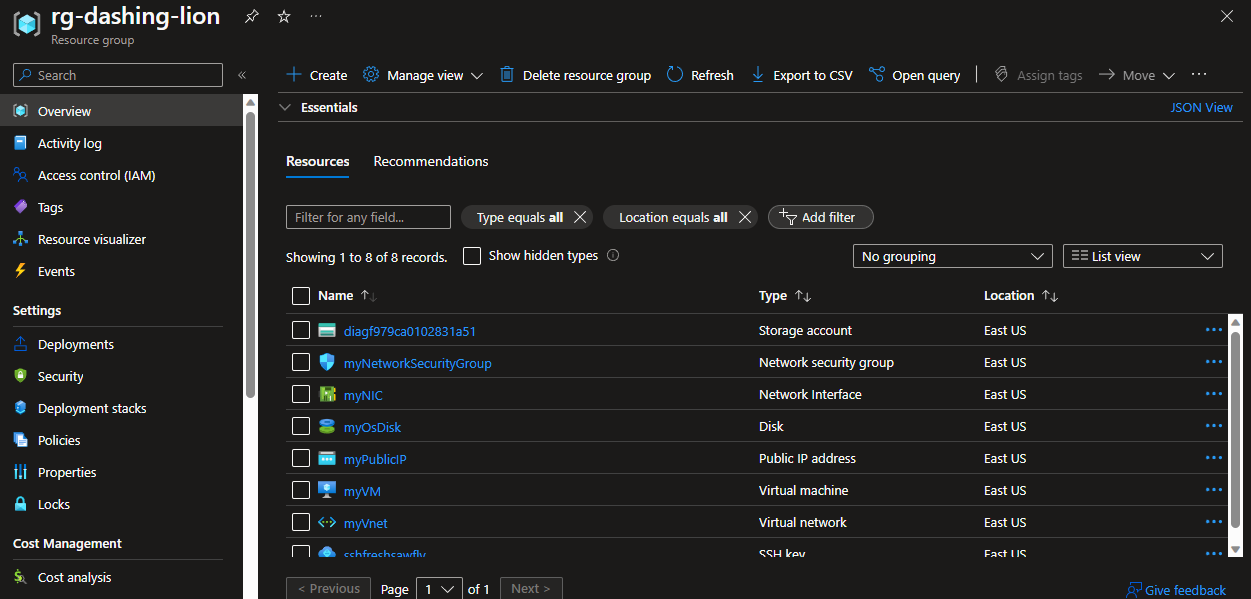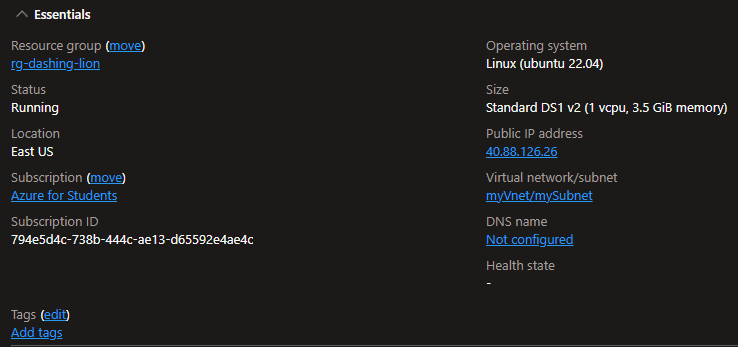This repository contains Terraform configuration files to deploy an Azure Virtual Machine (VM). The deployment process involves creating various Azure resources and configuring a VM for your use and ssh connection capacity.
Before you begin, make sure you have the following prerequisites:
- Terraform installed.
- An Azure subscription.
- Azure CLI installed and authenticated.
Follow these steps to deploy an Azure VM:
-
Clone this repository to your local machine.
-
Navigate to the repository directory.
-
Run the following command to initialize Terraform:
terraform init
-
Validate the Terraform configuration files:
terraform validate
-
Run the following command to deploy the Azure resources:
terraform apply
-
Once the deployment is complete, you can establish a ssh connection to the VM using the following command:
ssh -i linuxkey.pem azureuser@<public-ip-address>
Being the <public-ip-address> the public IP address of the VM generated by Azure
The Terraform configuration files are organized as follows:
├── main.tf
├── variables.tf
├── outputs.tf
├── ssh.tf
├── providers.tf
├── linuxkey.pem
Where linyxkey.pem is the private key generated by Microsoft service and stored as a file in the repository.
We are going to deep dive in the content of the essential files as follows:
This file contains the Terraform configuration to deploy the Azure resources. The resources deployed are:
-
A resource group.
resource "azurerm_resource_group" "rg" { location = var.resource_group_location name = random_pet.rg_name.id }
-
A virtual network.
resource "azurerm_virtual_network" "my_terraform_network" { name = "myVnet" address_space = ["10.0.0.0/16"] location = azurerm_resource_group.rg.location resource_group_name = azurerm_resource_group.rg.name }
-
A subnet.
resource "azurerm_subnet" "my_terraform_subnet" { name = "mySubnet" resource_group_name = azurerm_resource_group.rg.name virtual_network_name = azurerm_virtual_network.my_terraform_network.name address_prefixes = ["10.0.1.0/24"] }
-
A public IP address.
resource "azurerm_public_ip" "my_terraform_public_ip" { name = "myPublicIP" location = azurerm_resource_group.rg.location resource_group_name = azurerm_resource_group.rg.name allocation_method = "Dynamic" }
-
A network interface.
resource "azurerm_network_interface" "my_terraform_nic" { name = "myNIC" location = azurerm_resource_group.rg.location resource_group_name = azurerm_resource_group.rg.name ip_configuration { name = "my_nic_configuration" subnet_id = azurerm_subnet.my_terraform_subnet.id private_ip_address_allocation = "Dynamic" public_ip_address_id = azurerm_public_ip.my_terraform_public_ip.id } }
-
A network security group.
resource "azurerm_network_security_group" "my_terraform_nsg" { name = "myNetworkSecurityGroup" location = azurerm_resource_group.rg.location resource_group_name = azurerm_resource_group.rg.name security_rule { name = "SSH" priority = 1001 direction = "Inbound" access = "Allow" protocol = "Tcp" source_port_range = "*" destination_port_range = "22" source_address_prefix = "*" destination_address_prefix = "*" } }
-
A virtual machine.
resource "azurerm_linux_virtual_machine" "my_terraform_vm" { name = "myVM" location = azurerm_resource_group.rg.location resource_group_name = azurerm_resource_group.rg.name network_interface_ids = [azurerm_network_interface.my_terraform_nic.id] size = "Standard_DS1_v2" os_disk { name = "myOsDisk" caching = "ReadWrite" storage_account_type = "Premium_LRS" } source_image_reference { publisher = "Canonical" offer = "0001-com-ubuntu-server-jammy" sku = "22_04-lts-gen2" version = "latest" } computer_name = "hostname" admin_username = var.username admin_ssh_key { username = var.username public_key = jsondecode(azapi_resource_action.ssh_public_key_gen.output).publicKey } boot_diagnostics { storage_account_uri = azurerm_storage_account.my_storage_account.primary_blob_endpoint } }
This file contains the Terraform configuration to generate a ssh key pair. The key pair is generated using the Azure API and stored as a Terraform output.
resource "random_pet" "ssh_key_name" {
prefix = "ssh"
separator = ""
}
resource "azapi_resource_action" "ssh_public_key_gen" {
type = "Microsoft.Compute/sshPublicKeys@2022-11-01"
resource_id = azapi_resource.ssh_public_key.id
action = "generateKeyPair"
method = "POST"
response_export_values = ["publicKey", "privateKey"]
}
resource "azapi_resource" "ssh_public_key" {
type = "Microsoft.Compute/sshPublicKeys@2022-11-01"
name = random_pet.ssh_key_name.id
location = azurerm_resource_group.rg.location
parent_id = azurerm_resource_group.rg.id
}
output "key_data" {
value = jsondecode(azapi_resource_action.ssh_public_key_gen.output).publicKey
}
output "key_data_private" {
value = jsondecode(azapi_resource_action.ssh_public_key_gen.output).privateKey
}
resource "local_file" "linuxkey" {
filename="linuxkey.pem"
content=jsondecode(azapi_resource_action.ssh_public_key_gen.output).privateKey
}When terraform apply is executed, Terraform reads the configuration files in the current directory and generates an execution plan. The execution plan describes the actions that Terraform will take to deploy the resources specified in the configuration files and outputs the plan to the console.
Outputs are shown below:
Here we can see the public IP address of the VM. This IP address is used to establish a ssh connection to the VM. Also we can see the private key generated by Azure and stored as a file in the repository. Finally, it can be appreciated the resource group name.
When VM is deployed and we have the public IP address, we can establish a ssh connection to the VM using the following command:
ssh -i linuxkey.pem azureuser@<public-ip-address>And we can see the VM is up and running.
To see the resources deployed in Azure, we can go to the Azure Portal and navigate to the resource group created by Terraform.
Also, we can see the VM's essential info
To clean up the resources created by Terraform, run the following command:
terraform destroy






